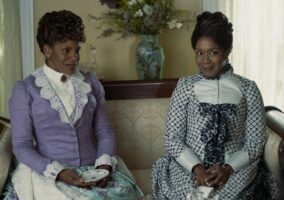![]() Pin
Pin
Is Carrie White’s satin gown from the 1976 horror film Carrie the most famous pink prom dress in movie history? Molly Ringwald might disagree, but we tend to think so. We’ve been building a case and establishing a set of criteria with this series; trying to show what distinguishes a merely good or slightly memorable film costume from one that is laden with meaning and highly referenced in popular culture. Let’s walk through the reasons why this costume is so firmly fixed in the minds of the public and what it represents to them, shall we?
![]() Pin
Pin
We noted with Princess Leia’s and Holly Golightly’s iconic looks that sometimes the most memorable and impactful movie costumes; the ones that wind up becoming visual shorthand for concepts larger than those found in the movies in which they appear, are so simple as to border on generic. That’s certainly the case with this dress, which is so free of embellishments and extraneous design elements that it’s barely distinguishable from a nightgown.
![]() Pin
Pin
We also noted, in discussing both the Princess Leia white robe and Judy Garland’s The Wizard of Oz costume, that film costumes that span a significant portion of the film allow the filmmaker and costume designer to make visual allusions to a character’s journey or degradation by showing wear and tear or significant damage to the costume over time. Carrie experiences one shocking, destiny-altering moment that changes the course of the story dramatically and the status of her costume over the last half hour or so of the film is an undeniably powerful and impossible-to-ignore visual allegory of her state of mind. The film’s costume designer Rosanna Norton knew that the stark effectiveness of her blood-spattered gown would be set off by the very blank-slate design that makes it so memorable.
![]() Pin
Pin
We noted in discussing another iconic pink gown (Marilyn Monroe’s “Diamond’s Are a Girl’s Best Friend” costume) that you can consider a film costume iconic if it repeats over time, inspiring homage after homage. It’s extremely notable that in both the 2002 and 2013 remakes of Carrie, her prom dress is a simple sleeveless pink gown; in each case, the costume designers opted to stay with the original design because it’s so easy to layer meaning onto it. No matter what else is going on in teen fashion at the time, a fairly simple pink gown remains the base sort of definitional image that comes to mind when you say “prom dress.” Speaking as people who’ve been commenting on fashion for a decade-and-a-half now, “It looks a little too prom dress” remains the go-to critique among our kind any time someone comes out in a simple pink gown. Carrie White’s gown is the Number One reason why plain pink gowns are considered the default, generic look of a classic prom gown.
![]() Pin
Pin
The final observation in our argument that this is an iconic cinematic look (as defined by us, using criteria we pulled out of our — devised): As we noted with Michelle Pfeiffer’s Catwoman costume, if there is significant screen time devoted to the making/securing of the outfit, with the characters voicing dialogue about the design or style, it’s a signal to stop and consider the importance of that costume design and what it’s actually doing and saying.
![]() Pin
Pin
Carrie is a shy, withdrawn, deeply repressed and abused girl whose sexual development came later than her contemporaries (as the film makes abundantly clear in its opening scene depicting Carrie’s traumatized reaction to her first period). She’s making the dress herself because she won’t receive any help or money from anyone, but she’s also doing it herself so she can express what she’s feeling for the first time, in an act of defiance toward her religious zealot of a mother.
![]() Pin
Pin
Hence the rather showy bra-lessness. It’s a perfectly on-trend style for 1976, which was well into the post-hippie, post-women’s lib era wherein decades if not centuries of women’s restrictive undergarments and foundation garments got tossed into the fire – sometimes literally. Which isn’t to suggest that Carrie’s making some sort of political statement. We wouldn’t go so far as to claim it’s akin to some sort of “I am woman” bra-burning allusion. It was simply the style of the time.
![]() Pin
Pin
Having said that, director Brian DePalma deliberately frames Spacek’s breasts and highlights her lack of bra because it demonstrates her sexual awakening and growing confidence. It’s right there in the script: “I can see your dirty pillows.” If the dress had been showier, or fussier or less classic in design, that line wouldn’t land so hard. Of course you can see them. That’s the whole point of the design. Carrie’s slowly opening up, allowing herself to be seen as desirable and sexual. “They’re called breasts, Mama.” As we noted with Marilyn Monroe’s gown, pink is not just a color that defines femininity in our culture, it also has a long history on film as a color denoting female sexuality – and could even be said to denote that point where female sexuality and raw power intersect.
![]() Pin
Pin
![]() Pin
Pin
Once she arrives at the prom, the film lingers for a while on the atmosphere and the building tension, but it also takes the time to show you how Carrie’s gown differs from everyone else’s. It’s not just a simpler look, but a slightly more revealing one than you see on any of the other girls.
![]() Pin
Pin
![]() Pin
Pin
This has the two-fold effect of highlighting Carrie’s growing sexual awareness and confidence while also making her appear more and more vulnerable as the night progresses toward its disastrous ending. She boldly displayed her handiwork and adult body to her mother, but it’s notable how she hoiked the dress up and covered herself in a shawl once she left home. Her dirty-pillows display to her mother was an act of bravado, but when she gets around her contemporaries, she does her best to withdraw and not make such a show of herself.
![]() Pin
Pin
And we should note just how prettily on-trend she was for 1976. The whole prom scene is a snapshot of mid-’70s teen fashions, but Spacek is deliberately styled to be as Love’s Baby Soft pretty and aspirationally fashionable as possible. The All-American girl as she was defined for the entire latter half of the 20th Century: white, blonde, blue-eyed and approachably beautiful. She’s Barbie, Marcia Brady and The Breck Girl all rolled into one; as perfectly teen-aspirational for the times as Molly Ringwald in The Breakfast Club or Natalie Wood in Rebel Without a Cause.
![]() Pin
Pin
To 1976 audiences, this look was like some sort of supernatural makeover, turning a shy, unprepossessing girl into a Seventeen magazine cover. A Cinderella without a godmother, the clock ticking down to her own personal midnight. Her simple, generic princess-prettiness is meant to be notable, to give a sense of pureness and cleanness.
![]() Pin
Pin
Bear in mind that DePalma ensured that the entire prom scene had a rising tension level, and the audience remains well aware that something awful is going to happen to her. It’s impossible to be happy for her, even as she’s happy; impossible not to be vaguely unsettled by her sudden beauty, knowing how precarious her self-worth is and how potentially dangerous it can be for anyone to challenge it at this moment. Again: if Spacek had a trendy disco dress or plucked eyebrows or a more showy style of hair or makeup, it would have detracted from the work this scene was doing. The shampoo-ad simplicity of her look, in the context of the darkness of the film, is practically begging to be ruined.
![]() Pin
Pin
Which is why the moment of her degradation hits so hard, even though we saw it coming, even though the audience in 1976 walked past film posters depicting Sissy Spacek covered in blood. To turn her into the 1970s ideal of the All-American prom queen and then force the audience to wait through an excruciating scene in which her prettiness and her transformation are commented on by everyone, knowing that disaster is coming, is why the film remains such a classic.
![]() Pin
Pin
Carrie is lauded most for the exquisitely rising tension DePalma creates, using every tool available to him as a filmmaker. The costume design of this gown (along with Spacek’s makeover) is as potent a tool to that effect as the music, lighting and camera effect he deployed to make the scene so hard to watch.
![]() Pin
Pin
More blood landed on Sissy Spacek than ever could have fit in the relatively small bucket suspended over her, but that was entirely the point of it. Just as her prom queen look was so purely, simply pretty, this moment had to be as overwhelmingly ugly as DePalma could make it. She couldn’t be splashed with blood or doused with, she had to be drenched in it. She couldn’t just be embarrassed in front of her peers, she had to be dehumanized instantly, turned as quickly as possible from a figure of aspirational beauty to one of disgust and horror.
![]() Pin
Pin
Because it went on that journey with her, the audience can feel her mind snap at that moment and completely understand why. She turned herself into a swan and they punished her for it. In this moment, we aren’t horrified by Carrie, we’re horrified for her.
![]() Pin
Pin
![]() Pin
Pin
There’s also the undeniable symbolism of the blood itself, in the context of the film’s religious and sexual themes. The pink of the gown makes a perfect backdrop for the river of blood running down it, combining allusions of female sexuality with the horror of death. Carrie’s mother believes in a particularly violent and bloody form of Christian evangelicism and she has raised Carrie to believe that her own body, her own desires are sinful and dangerous. This isn’t the blood of a righteous martyr. It’s the blood of sin. It’s Carrie’s traumatizing and transformational menstrual blood multiplying tenfold and turning into a deluge of evil sexuality that engulfs her, destroying everyone around her, just as her mother predicted. This is why DePalma lingers on that scene of her bathing, with its allusions to baptism. She is washing off the sin of her sexuality even as he displays her naked body to the audience, as if to point out that even then, she can’t escape the social forces that equate her body with sin, her sexuality with destruction.
[Stills: United Artists via Tom and Lorenzo]
Yea or Nay: Gucci Long G Hexagon Print Wool Silk Dress Next Post:
Windsor Castle’s Wartime Pantomime Pictures Revealed
-
 Pin
Pin
Pop Style Opinionfest: MY MOM JAYNE, I’M YOUR VENUS, and More of Carrie Bradshaw Acting...
-
 Pin
Pin
RUPAUL’S DRAG RACE ALL STARS: Tournament of All Stars Snatch Game
-
 Pin
Pin
THE GILDED AGE: Love is Never Easy
Please review our Community Guidelines before posting a comment. Thank you!
